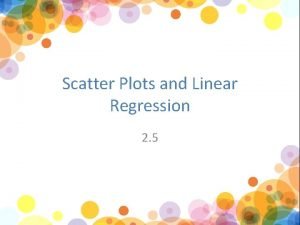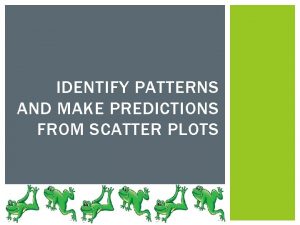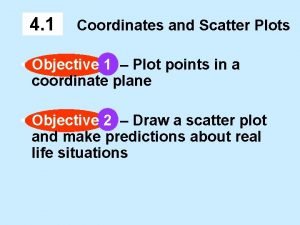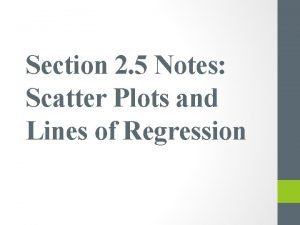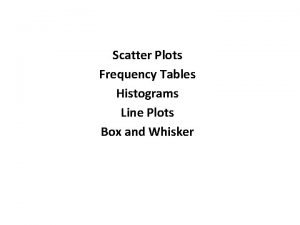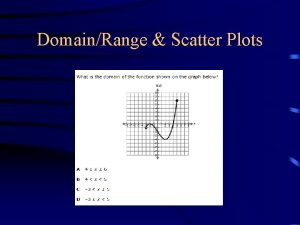Scatter plots Adapted from http www stat ncsu














- Slides: 14

Scatter plots Adapted from http: //www. stat. ncsu. edu/people/reiland/courses/st 350/

Results of controlled experiment supervised by law enforcement officials Here, we have two quantitative variables for each of 16 students. Student Beers Blood Alcohol 1 5 0. 1 2 2 0. 03 1) How many beers they drank, and 3 9 0. 19 6 7 0. 095 7 3 0. 07 2) Their blood alcohol level (BAC) 9 3 0. 02 11 4 0. 07 13 5 0. 085 4 8 0. 12 5 3 0. 04 8 5 0. 06 10 5 0. 05 12 6 0. 1 14 7 0. 09 15 1 0. 01 16 4 0. 05 We are interested in the relationship between the two variables: How is one affected by changes in the other one?

Scatterplot: Blood Alcohol Content vs Number of Beers In a scatterplot, one axis is used to represent each of the variables, and the data are plotted as points on the graph. Student Beers BAC 1 5 0. 1 2 2 0. 03 3 9 0. 19 6 7 0. 095 7 3 0. 07 9 3 0. 02 11 4 0. 07 13 5 0. 085 4 8 0. 12 5 3 0. 04 8 5 0. 06 10 5 0. 05 12 6 0. 1 14 7 0. 09 15 1 0. 01 16 4 0. 05

Explanatory and response variables A response variable measures or records an outcome of a study. An explanatory variable explains changes in the response variable. Typically, the explanatory or independent variable is plotted on the x axis, and the response or dependent variable is plotted on the y axis. Response (dependent) variable: blood alcohol content y x Explanatory (independent) variable: number of beers

Some plots don’t have clear explanatory and response variables. Do calories explain sodium amounts? Does percent return on Treasury bills explain percent return on common stocks?

Interpreting scatterplots After plotting two variables on a scatterplot, we describe the relationship by examining the form, direction, and strength of the association. We look for an overall pattern … Ø Form: linear, curved, clusters, no pattern Ø Direction: positive, negative, no direction Ø Strength: how closely the points fit the “form” … and deviations from that pattern. Ø Outliers

Form and direction of an association Linear No relationship Nonlinear

Positive association: High values of one variable tend to occur together with high values of the other variable. Negative association: High values of one variable tend to occur together with low values of the other variable.

No relationship: X and Y vary independently. Knowing X tells you nothing about Y. One way to think about this is to remember the following: The equation for this line is y = 5. x is not involved.

Strength of the association The strength of the relationship between the two variables can be seen by how much variation, or scatter, there is around the main form. With a strong relationship, you can get a pretty good estimate of y if you know x. With a weak relationship, for any x you might get a wide range of y values.

This is a weak relationship. For a particular state median household income, you can’t predict the state per capita income very well. This is a very strong relationship. The daily amount of gas consumed can be predicted quite accurately for a given temperature value.

How to scale a scatterplot Same data in all four plots Using an inappropriate scale for a scatterplot can give an incorrect impression. Both variables should be given a similar amount of space: • Plot roughly square • Points should occupy all the plot space (no blank space)

Outliers An outlier is a data value that has a very low probability of occurrence (i. e. , it is unusual or unexpected). In a scatterplot, outliers are points that fall outside of the overall pattern of the relationship.

Not an outlier: Outliers The upper right-hand point here is not an outlier of the relationship—It is what you would expect for this many beers given the linear relationship between beers/weight and blood alcohol. This point is not in line with the others, so it is an outlier of the relationship.
 Graphing scatter plots
Graphing scatter plots Scatter plots and data student handout 4
Scatter plots and data student handout 4 2-5 scatter plots and lines of regression
2-5 scatter plots and lines of regression Unit scatter plots and data quiz 1
Unit scatter plots and data quiz 1 Draw a correlation
Draw a correlation Patterns in scatter plots
Patterns in scatter plots Scatter plot data table
Scatter plot data table 4-1 construct and interpret scatter plot
4-1 construct and interpret scatter plot Scatter plot matching activity
Scatter plot matching activity 2-5 scatter plots and lines of regression
2-5 scatter plots and lines of regression Scatter plots and trend lines worksheet
Scatter plots and trend lines worksheet Scatter plot frequency distribution
Scatter plot frequency distribution 3-5 scatter plots and lines of fit
3-5 scatter plots and lines of fit Scatter plot graph calculator
Scatter plot graph calculator Describing trends in scatter plots
Describing trends in scatter plots


